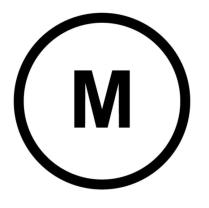What are some electrical symbols?
Sure, here are some common electrical symbols used in circuit diagrams and electrical schematics:
Resistor: Represents resistance in a circuit. It's typically represented by a zigzag line.
Capacitor: Represents capacitance. It looks like two parallel lines.
Inductor: Represents inductance. It's usually shown as a coil or several loops.
Battery: Represents a power source. It's depicted as a series of short and long parallel lines.
Ground: Symbolizes a connection to the ground. It's a horizontal line with three downward-pointing lines.
Switch: Represents a device that can open or close a circuit. It's usually a line interrupted by a gap.
Fuse: Symbolizes a safety device that breaks a circuit when there's an overload. It's represented by a line with a wavy line in it.
Diode: Represents a semiconductor component allowing current to flow in one direction. It looks like an arrow pointing in one direction.
Transistor: Represents a semiconductor device used for amplification or switching. It has various symbols based on the type (e.g., NPN, PNP).
Light Bulb: Represents a light source. It's shown as a circle with a cross or lines inside.
Voltmeter: Represents a device used to measure voltage. It's depicted with a V inside a circle.
Ammeter: Represents a device used to measure current. It's usually depicted with an A inside a circle.
These symbols are standardized and widely used in electrical engineering and circuit design to represent various components and connections in a circuit diagram.
Examples of common electrical symbols used in diagrams?
Here are some examples of common electrical symbols used in diagrams:
Basic Components:
- Wire: Represented by a single line, sometimes with different line styles to indicate various types (e.g., solid for power, dashed for ground).
- Battery: Depicted as two rectangles connected by a line, with positive (+) and negative (-) terminals indicated.
- Resistor: Zigzag lines denote resistors, with different shapes and values indicated by additional markings.
- Capacitor: Two parallel lines represent capacitors, with additional markings indicating value and type.
- Inductor: A coil symbol represents inductors, with varying shapes and values indicated.
- Switch: A switch symbol varies depending on its type (e.g., single-pole, double-pole), but generally involves lines crossing or intersecting to represent open and closed states.
- Fuse: A symbol resembling a box with a line inside represents a fuse.
- Diode: A triangle with a line segment inside, pointing in one direction, represents a diode.
Sources and Loads:
- AC Voltage Source: A sine wave symbol represents an AC voltage source, sometimes with an additional square wave for AC current.
- DC Voltage Source: Two lines with positive (+) and negative (-) symbols represent a DC voltage source.
- Ground: A horizontal line with a vertical line extending downwards represents a ground connection.
- Motor: A symbol resembling a circle with three lines radiating outwards represents a motor.
- Lamp: A small circle with a filament inside represents a lamp.
Other Symbols:
- Junction: A small circle represents a junction where multiple wires connect.
- Transistor: A symbol resembling a triangle with two lines on one side and one line on the other represents a transistor.
- Op-Amp: A triangle with two inputs and two outputs represents an operational amplifier.
- Transformer: A rectangle with two or more lines inside represents a transformer.
- Speaker: A stylized speaker symbol represents a speaker.
- Antenna: A line with a triangle or other symbol represents an antenna.
These are just a few examples, and there are many other symbols used in electrical diagrams. It's important to consult a reference guide or specific diagram legend for accurate interpretation of symbols in any given context.
Here are some resources where you can find more information about electrical symbols:
- Electrical and Electronics Symbols and Meanings: https://www.edrawsoft.com/symbols/
- Basic Schematic Symbols: https://www.edrawsoft.com/basic-electrical-symbols.html
- Typical Electrical Drawing Symbols and Conventions: https://profwagner.com/ProfWagner/4520/FP/NECA100.pdf







